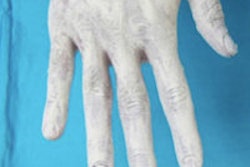
Driven by continued digitization of x-ray systems and increasing healthcare investments in emerging regions, the global market for x-ray equipment reached 7.5 billion euros ($10 billion) in revenue in 2012 and is expected to increase by 18% to reach 9 billion euros ($12 billion) in 2017, according to market research firm IMS Research.
General radiography is undergoing a major transition toward digital radiography (DR) technology based on flat-panel detectors, with affordable offerings such as retrofit kits driving migration away from film in many cash-strapped regions, analyst for medical electronics Sarah Jones said in a statement, who also wrote a column for AuntMinnieEurope.com. The report covers x-ray equipment used for medical, dental, veterinary applications, and other purposes, according to IMS.
While shipments of flat-panel detector and retrofit flat-panel detector DR systems produced an estimated 15% of annual general radiography shipments in 2012, that figure is expected to reach 25% in 2017, IMS said.
IMS noted the mammography market is already dominated by flat-panel detector-based full-field digital mammography systems, led by adoption in mature regions. Purchasing in emerging regions is relatively low, however, with not much demand for breast screening, and few healthcare providers are able to purchase the costly equipment, according to the company.
Interventional and mobile C-arm equipment sales are benefitting from a growing trend toward minimally invasive surgery, according to IMS. Advanced systems with digital technology and advanced navigation software are driving growth in mobile C-arm x-ray, while interventional x-ray is already dominated by digital technology and is being spurred on by new installations of hybrid operating rooms that combine multiple imaging modalities and full surgical equipment in one room, the company said.
Furthermore, hospitals are becoming more receptive to new procedures like transcatheter aortic valve implantation (TAVI) as an alternative to open-heart surgery. These procedures are performed using high-end mobile C-arm equipment with flat-panel detector technology, IMS said.
Outside of radiology, IMS said that veterinary x-ray is also seeing a transition to flat-panel detector technology in developed regions, with existing analog systems now being replaced by computed radiography and flat-panel detector x-ray equipment. Wireless flat-panel detector usage is increasing in the equine veterinary market, and fixed equipment is increasingly used in smaller animal practices, the company said.
While the dental x-ray segment is currently dominated by analog film, a major shift to digital sensors and photostimulable phosphor imaging is underway, according to the firm. In addition, extraoral imaging is increasing in popularity, with more use of flat-panel detectors based on complementary metal-oxide-semiconductor (CMOS) technology.
Overall, challenging global economic conditions have significantly affected the x-ray market, IMS said. While delayed purchasing and slower demand are predicted to continue in the short term, these hard times are also creating an opportunity for lower-cost digital packages such as retrofit flat-panel detector panels/kits, IMS said.
The global x-ray market is expected to recover over the longer term, however. The main market drivers will be emerging regions, particularly in China, India, Latin America, and parts of southeast Asia, IMS said. Flat-panel detectors also will become the most common technology type, owing to its increased efficiency, image quality, and lower lifetime cost of ownership, according to the firm.
Digital x-ray demand will also be sustained by the continued digitalization of healthcare, IMS said.



















